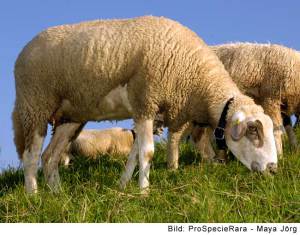Spiegelschaf (CH)
Description
A medium-sized white sheep on long legs representing the old local sheep type with long narrow head and ears of medium length. Polled. Dark markings around the eyes and the ears which become brighter at old age are characteristic for the breed. The wool is rather fine, often twind. Head, belly and legs are woolles. They have strong ankles and hard claws. The breed is non-seasonal. Age at first lambing is 18 months.
General and History
The breed probably descends from old Bünden sheep. It is assumed that the breed has also been influenced by Luzein and Seiden, and by Montafon and Carinthian. After 1938 decrease of population. The breed survived on a single farm. Herdbook foundation in 1997. Since 2004 acknowledges as Swiss breed
Distribution in the past and today
Since the beginning of the conservation project in 1986 with 10 ewes and 3 rams from 3 breeders, the number of breeder has been increasing to 180 in German-speaking Switzerland, but also in other cantons.
Utilization
Medium fattening potential on rough feed basis is aimed at. The meat is finely fibred and tastes well. Good maternal characteristics.
Breeding aims
Within the frame of extensive management, breeding focuses on resistance, longevity, good rearing performance and good fattening performance on rough feed basis, with gene conservation having first priority.
Performance
Animals are undemanding, very adaptable and frugal and rarely contract foot rot of sheep as claws are robust and hard.
Body weight: 60-80kg (m), 50-65 (w)
Withers height: 63-73cm (m), 70-80cm (w)
Lambing percentage: 200%
Processing and products
Meat: fine-fibrously, low-fat, very tasty as fresh, drily meat, hard smoked sausage or boiled salami
Wool: exept lambswool, caprets or from Kardwolle Duvets and pillow, moreover, felt works, lambskins
Literature
· ProSpecieRara: Nutztierkompass, Basel, 2012 (https://www.prospecierara.ch/de/shop/article/nutztierkompass)
· Schafrassen in den Alpen, Antje Feldmann, Ursula Bietzker, Dr. Christian Mendel, Gesellschaft zur Erhaltung alter und gefährdeter Haustierrassen e.V. - GEH.
· Brochure «Ressources zoogénétiques de l’agriculture suisse», 20.09.2021, Office Fédéral de l'Agriculture, OFAG
- http://www.spiegelschaf.ch/
- https://www.prospecierara.ch/tiere/rassenportraets/schafportraets/spiegelschaf.html
- www.tierische-raritaeten.ch/index.php?lang=de&page=find&Rasse=R010
- http://www.ig-oss.ch
- http://www.permakultur.at/themen/tiere/schafe/Spiegelschaf.htm
- http://www.spycher-handwerk.ch/der-betrieb/archehof-tiere/schafe/
- http://filzszene-gr.ch/unsere-projekte/prospezierara-gutesiegel/








